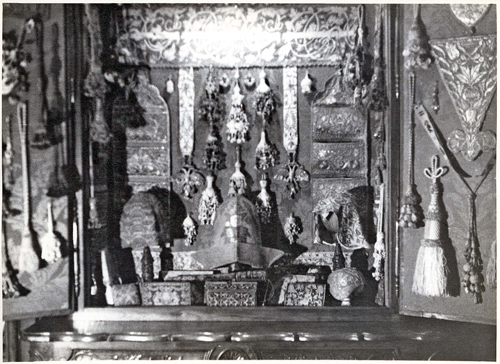Richard Cranch Greenleaf (1887–1961) was a prolific collector of lace, costume, and textiles. To a large extent, the strength of Cooper-Hewitt’s collection in these areas can be attributed to his generosity. Starting in 1950, Greenleaf began donating groups of lace, small accessories such as purses and coifs, and finely woven European silks and embroidered textiles. His largest gift to Cooper-Hewitt came in the form of a 1962 bequest of over seven hundred objects. The high quality of the lace, waistcoats, tassels, and other textiles he donated illustrates the deep knowledge that he developed during a lifetime of passionate collecting.

Waistcoat, France, 1790, Silk embroidery on silk plain weave, linen back, 60 x 50 cm (23 5/8 x 19 11/16 in.), Cooper-Hewitt, National Design Museum, Smithsonian Institution, Bequest of Richard Cranch Greenleaf in memory of his mother, Adeline Emma Greenleaf, Photo: Steve Tague
Greenleaf lived in the United States and France, where he cultivated important relationships with dealers, collectors, and curators. After the death of his father in 1914, Greenleaf and his mother moved to France. He purchased a home in Barbizon, where he lived until 1941. The escalation of WWII compelled him to return to the United States, but he was unable to bring his collection with him. A family friend, George Marois, helped Greenleaf pack his collection, and they took it to Marois’s farm, hiding groups of objects in unassuming places around the property. Greenleaf took his favorite pieces of lace and shaped them together until they resembled a modest pin cushion. He then traveled to Lisbon, where he secured passage to New York. Remarkably, Greenleaf was able to retrieve his entire collection after the end of the war, although German troops had moved through the area. During his years in France and the United States, Greenleaf sought the best examples of lace and other textiles. He was able to purchase important pieces at auction from the collections of Madame Jules Porgès, Alfred Lescure, and the Osterreith collection. His apartment at 277 Park Avenue in New York became a showplace where he installed his favorite objects in special cabinets and shared them with friends and colleagues.

Black-and-white photograph of Richard Greenleaf’s collection at 277 Park Avenue, New York, NY, undated 12.6 x 17.2 cm (4 15/16 x 6 3/4 in.) Textiles Department, Cooper-Hewitt, National Design Museum
Even as his collection grew, Greenleaf willingly donated and loaned objects. American Art News reported in 1915 that he had donated lace to the Minneapolis Institute of Arts, and he frequently loaned pieces to the Metropolitan Museum of Art and Cooper Union, where he had close relationships with the curators. For a Cooper Union exhibition entitled Conspicuous Waist, he loaned nearly forty embroidered men’s waistcoats and embroidery samples. In 1917, he was among a group of lace experts who founded the Needle and Bobbin Club and became the first editor of its bulletin. He also served on the Advisory Council of the Cooper Union Museum. The significance of his bequest was showcased in 1964 when Cooper Union displayed his textile collection in its entirety. The Greenleaf collection remains a curatorial favorite today; the exceptional quality of the pieces and his enthusiasm for menswear of the eighteenth century are noteworthy. Cooper-Hewitt continues to proudly exhibit objects from this important collection.